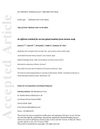Epidermal/Dermal Separation Techniques and Analysis of Cell Populations in Human Skin Sheets
December 2022
in “
The journal of investigative dermatology/Journal of investigative dermatology
”

TLDR Choosing the right method to separate skin layers is key for good skin cell research.
The document reviews various methods for separating the epidermis and dermis in human skin samples, crucial for skin-related research. The methods are enzymatic, using proteolytic enzymes like dispase for high yields of viable cells; chemical, using neutral salts or acids, suitable for preparing high-quality RNA and DNA or for imaging; and mechanical, each with unique benefits and limitations. It also discusses in vivo and ex vivo skin suction, heat treatment, milling cutter treatment, and stretching. The document provides protocols for skin sample excision, processing, and analysis, and imaging of epidermal and dermal sheets. The choice of separation method depends on the specific experimental question being addressed.




